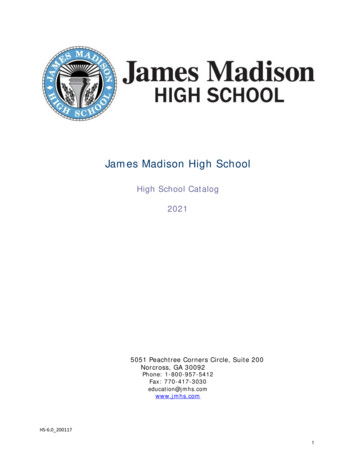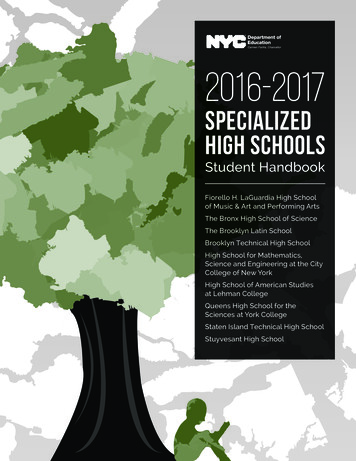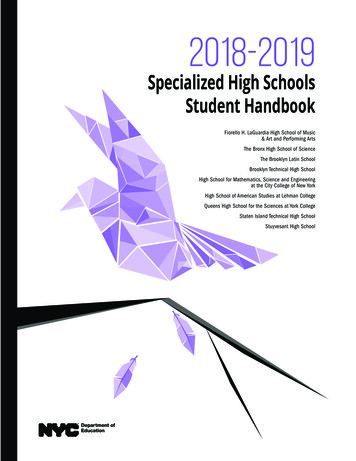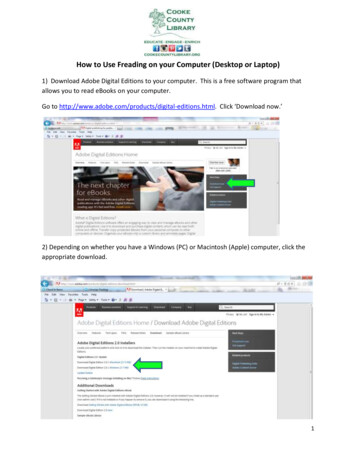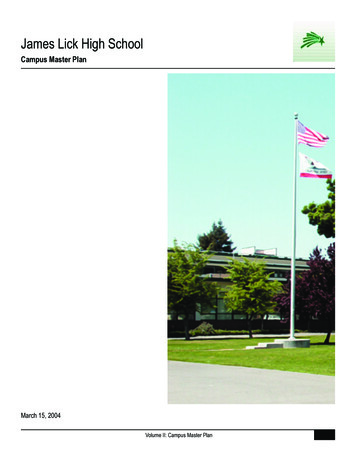
Transcription
James Lick High SchoolCampus Master PlanMarch 15, 2004Volume II: Campus Master Plan
James Lick High SchoolMaster Plan ContentsVolume I: District Master PlanVolume II: Campus Master Plan Andrew P. Hill High School Campus Master Plan Foothill High School Campus Master Plan Independence High School Campus Master Plan James Lick High School Campus Master Plan Mt. Pleasant High School Campus Master Plan Oak Grove High School Campus Master Plan Piedmont Hills High School Campus Master Plan Santa Teresa High School Campus Master Plan Silver Creek High School Campus Master Plan W. C. Overfelt High School Campus Master Plan Yerba Buena High School Campus Master Plan Independence Adult Education Campus Master Plan W.C. Overfelt Adult Education Campus Master Plan Alternative Education Campus Master PlanVolume III: Preliminary Needs Assessment District Preliminary Needs Assessment Andrew P. Hill High School Preliminary Needs Assessment Foothill High School Preliminary Needs Assessment Independence High School Preliminary Needs Assessment James Lick High School Preliminary Needs Assessment Mt. Pleasant High School Preliminary Needs Assessment Oak Grove High School Preliminary Needs Assessment Piedmont Hills High School Preliminary Needs Assessment Santa Teresa High School Preliminary Needs Assessment Silver Creek High School Preliminary Needs Assessment W. C. Overfelt High School Preliminary Needs Assessment Yerba Buena High School Preliminary Needs Assessment Independence Adult Education Preliminary Needs Assessment W.C. Overfelt Adult Education Preliminary Needs Assessment Alternative Education Preliminary Needs AssessmentVolume IV: Phase I & Phase II Projects District Phase I Projects District Phase II ProjectsVolume V: District Facility Design GuidelinesVolume VI: District Facility Outline SpecificationsVolume VII: Cost Estimation AnalysisVolume VIII: State FundingVolume IX: District Demographics StudyVolume II: Campus Master Plan
James Lick High SchoolCampus Master PlanEast Side Union High SchoolDistrict Mission StatementIt is the mission of East SideUnion High School District toprovide a safe and effectivelearning environment: to providesupport to all students andfamilies; to strive for continuousimprovement; and to implementclear measurements of success.Table of Contents Introduction Glossary of Terms Master List of District Priority Projects12-67-8Campus Measure G Scope of Work Introduction to the Proposed Campus Measure G Scope of Work Campus Measure G Scope Summary Campus Measure G Existing/Demolition Plan Campus Measure G Scope Diagram Campus Measure G Teaching Station Summary Campus Measure G Scope Probable Construction Cost Summary Campus Measure G Scope Legend of Symbols Campus Measure G Scope Probable Construction Cost910111213141516-36Master Plan Full Scope of Work Introduction to the Proposed Master Plan Full Scope of Work Master Plan Full Scope Summary Master Plan Full Scope Existing/Demolition Plan Master Plan Full Scope Diagram Master Plan Full Scope Teaching Station Summary Master Plan Full Scope Probable Construction Cost Summary Master Plan Full Scope Legend of Symbols Master Plan Full Scope Probable Construction Cost373839404142-434445-69Appendix Construction Category Descriptions Errata/Revision History70-9798Volume II: Campus Master Plan
James Lick High SchoolIntroduction to the Master PlanOn March 5, 2002, the East Side Union High School District (ESUHSD) passed the Measure “G”Bond with 298,000,000 for facilities Improvements. With a portion of the funds generated from thisbond, the ESUHSD proposed to begin a number of modernization and new construction projects atthe campuses across the District. These projects include, but are not limited to, replacing relocatableclassrooms with permanent buildings, modernizing existing classrooms, modernizing existing restroomsand locker rooms, providing increased safety and security by utilizing perimeter fencing, video camerasurveillance and exterior lighting, and improving campus wide technology.Measure G, as presented to the voters, contained a Bond Project List which listed specific projects foreach campus across the District. In order to prioritize the needs of each school, the District developedan Executive Summary that works as a “scope of work planning guide” for the modernization of eachschool, listing projects and assigning priorities and base costs for each campus.The ESUHSD selected Perkins & Will to provide a District Master Plan for the Measure G fundedprojects as well as future campus needs. The comprehensive Master Plan is comprised of five majorparts that work together to outline the needs, scope of work and methods by which all of the new workwill be completed.The Phase I and Phase II Projects (formally titled “Quick Start Projects”) were the first part of theMaster Plan. The Projects List as defined by the Defined was first reviewed in June 2003, this portionof the Master Plan describes campus improvement projects that had a short lead time and little physicalor economic impact on the overall planning efforts at each campus. Phase I projects included thoseprojects that had been implemented by the District and were already underway at the time. Phase IIprojects were scheduled to begin in late 2003 or early 2004.The Preliminary Needs Assessment was the second report delivered as part of the comprehensiveMaster Plan. This portion of the Master Plan contains a detailed analysis of each campus and theinherent needs of each school. Included in this document are analysis of existing campus conditions,probable construction costs and existing facility assessments that document the investigations,evaluations and recommendations of Perkins & Will and its consultants.The Campus Master Plan is the third part of the comprehensive Master Plan. It works as a companionto the first two parts of the Master Plan and outlines the scope of work and probable construction costsfor the projects funded under Measure G as well as the complete Master Plan for each campus. TheCampus Master Plan document describes a scope of work at a campus level and works in conjunctionwith the two final parts of the Master Plan, the District Facility Design Guidelines and the DistrictOutline Specifications. These two documents provide a more detailed outline of the work at a buildinglevel and describe specific materials and methods to be used on District construction projects.This Campus Master Plan for Mt. Pleasant High School is provided as a recommendation to theDistrict of the scope of work to be performed under Measure G funding along with considerations forfuture campus improvements. It is a result of the synthesis of information provided by the District, theCampus Steering Committees and the Master Plan consulting team.Volume II: Campus Master Plan1
James Lick High SchoolGlossary of TermsAllocated Construction Budget-- 72% of the Project Budget reserved for construction only, includingdesign contingencies and escalation. The remaining 28% is reserved for District associated projectcosts, including testing, fees, project management and project contingencies.Balance of Funds--The difference between the Allocated Construction Budget and the Total ProbableConstruction Cost.Bond Summary Budget--Total Measure G funds allotted to each campus per the Citizen BondOversight Committee Annual Report, dated August, 2003.Campus Priority Projects--Amount the District anticipates spending for select sub-category projectsdeemed Campus Priority Projects. It does not include contingency and escalation costs. These projectsdo not fall under the heading Campus Projects.Campus Project--A project identified through the Master Plan Preliminary Needs Assessment processthat does not fall within the projects listed in the Measure G Bond Executive Summary or the CitizenBond Oversight Committee Annual Report Bond Summary. A Campus Project is considered for masterplanning purposes, but it may not to be funded by Measure G.Campus Projects Probable Construction Cost--Amount each campus anticipates expending fortheir own projects above and beyond the District Priority Projects, including contingency and escalationcosts.CDE Total Enrollment 2002-2003 SY--The number of students at each campus for the 2002-2003School Year. This number was provided by ESUHSD and is based on the California Department ofEducation’s CBED demographic reports for enrollment reported in October, 2002.Current Capacity--The number of students in each campus at the District Standard of 26.8 loading perTeaching Station.Current Loading--The average number of students housed at each teaching station per campus.Design Contingency—A multiplier applied to base probable construction costs to account forunforeseeable conditions or unknown constraints that may be revealed during design and thereby affectconstruction cost. This multiplier has been set at 15%.District Priority Project (DPP)--A project considered to fall within the projects listed in the Measure GBond or the Executive Summary Project Lists, and which is planned to be under construction contractafter September 30, 2004 and funded from Measure G funds.District Priority Projects (DPP) Probable Construction Cost--Total construction amount eachcampus anticipates expending for those projects scheduled to be in a construction contract afterSeptember 30, 2004. A design contingency of 15% and a cost escalation of either 12% or 20% isapplied for a period of 3 or 5 years respectively. This amount is applied to both DPP and the DesignContingency.District Standard Loading--The number of students housed at each Teaching Station as a DistrictStandard.Volume II: Campus Master Plan2
James Lick High SchoolGlossary of TermsEscalation—A multiplier applied to the sum of the base probable construction costs and designcontingency to account for construction costs increasing due to inflation and market conditions over time.Applied as a base, uncompounded percentage rate added for each year from 2003 to the projected midpoint of construction.Executive Summary Budget--Total Measure G funds allotted to each campus per the ExecutiveSummary “Bond Measures School Safety and Student Success”, no date.Existing Teaching Station (Permanent Building)--The number of teaching stations located in apermanent building.Existing Teaching Stations (Relocatable)--The number of Teaching Stations located in non-interimrelocatable buildings.General Classroom--A Standard Teaching Station room.Interim Housing—Relocatable Teaching Stations required to house classes during construction.Master List of District Priority ProjectsA categorized list of project types distilled by Perkins & Will from the campus project lists containedwithin the Measure G Bond Executive Summary and the Citizen Bond Oversight Committee AnnualReport Bond Summary.Master Plan Balance of Funds--The difference between Allocated Construction Budget and TotalMaster Plan Probable Construction Cost.Master Plan Enrollment--The number of students anticipated at each campus for the purposes ofgenerating the Preliminary Needs Assessment. This number was established by ESUHSD.Measure A--The General Obligation Bond prior to Measure G, passed by East Side Union High SchoolDistrict voters in 1991, now expended.Measure G--A General Obligation Bond of 298,000,000, passed by East Side Union High School Districtvoters on March 5, 2002.Modernization Level 1--A general construction project that replaces most finishes and some fixtures butdoes not change existing wall configurations. Refer to the Appendix for an itemized description.Modernization Level 2--A general construction project that replaces all finishes and fixtures, typicallyfor it’s existing use, sometimes requiring relocation of non-bearing partitions. Upgraded mechanical,plumbing, electrical, technology and new roofing are included. Refer to the Appendix for an itemizeddescription.Net Enrollment Change--The difference between Enrollment 2002-2003 and Master Plan Enrollment.Net Relocatables Replaced--The difference between Existing Teaching Stations (Relocatables)and Teaching Stations Net Change. A positive number indicates the number of new construction ofVolume II: Campus Master Plan3
James Lick High SchoolGlossary of Termsclassrooms to replace relocatable buildings by the end of Measure G construction. A zero indicatesthat the existing number of permanent Teaching Stations should accommodate the projected enrollmentpopulation under the District’s Standard Loading, without consideration of other modernization orcampus needs.New Construction--A general construction project providing additional program area not within anexisting structure.Other Funding--Monies for specific projects from either City or private entities.Other Labs—A specialized instruction classroom, often larger than a General Classroom, such as aComputer Lab, Art or Music Classroom and their associated support spaces.Phase I Construction Cost--Total construction amount the District anticipates expending for thoseprojects included in a construction contract before October 1, 2003. Contingency and escalation costsare not applied to Phase I Projects.Phase II Probable Construction Cost--Total construction amount the District anticipates expending forthose projects included in a construction contract between October 1, 2003 and September 30, 2004. Adesign contingency of 15% is applied. In addition, a 4% escalation cost amount is applied to both PhaseII project costs and the design contingency.Phase I Project--A project that is under construction contract before October 1, 2003, to be funded eitherfrom Measure G allocations or under the District’s Maintenance & Operations Budget.Phase II Project--A project that is planned to be under construction contract between October 1, 2003and September 30, 2004, to be funded from Measure G funds.Projected Enrollment 2011--The number of students anticipated in each campus for the 2001-2012School Year. This number was provided by enrollment projection consultants in a report from 2000.These projections did not account for the effects of students attending Evergreen Valley High School.Projected Enrollment Oct. 2005--The number of students anticipated at each campus for the 20052006 School Year. This number was provided by the District’s enrollment projection consultants in areport from 2000. These projections did not account for the effects of students attending EvergreenValley High School.Recently Modernized Classroom—A Teaching Station modernized within 10 years of the PreliminaryNeeds Assessment (1993 or later), presumed by the District to be predominantly compliant with recentDSA requirements.Reconstruction--A general construction project that removes all finishes and infrastructure of an existingbuilding in order to expand or reconfigure that building, sometimes for another use. Reconstructiontypically will require seismic and structural upgrades of the building structure. All new mechanical,plumbing, electrical, technology, exterior finishes, roofing, interior finishes are included. Refer to theAppendix for an itemized description.Relocatable Classroom--A portable building housing at least one General Classroom.Volume II: Campus Master Plan4
James Lick High SchoolGlossary of TermsRelocatable Non-Teaching Station—A portable building housing physical education classes,administration, storage or other similar functions.Relocatable Other Labs--A portable building housing at least one specialized instruction classroom.Relocatable Science Lab--A portable building housing at least one Science Lab and designed forscience classes.Revised Teaching Station Requirement--The total number of Teaching Stations required per campus,based on the Master Plan Enrollment numbers divided by the District Standard Loading.Science Lab--A Teaching Station room, designed and outfitted for science classes.State Eligibility Budget--The amount of state modernization grant funding for which a campus iscurrently eligible under the State Allocation Board’s AB 16 School Facility Program Regulations, per theDistrict’s State Eligibility Consultant’s report.Teaching Station—A classroom or space where instruction by teachers takes place, where studentsare assigned, and are counted for the purpose of determining the project’s enrollment capacity, asdetermined by the California Department of Education. Standard Teaching Stations include class lecturerooms, reading areas, special education, and independent study using technology learning centers withinclassrooms. Large Teaching Stations include rooms for large group lecture, video presentations andhands-on activities. Science Laboratories and other specialized instruction classrooms are consideredto be Teaching Stations. Rooms where Physical Education and Health occur, however, are not countedas Teaching Stations.Teaching Stations Net Change--The difference between Total Existing Teaching Stations and TeachingStations Needed.Total Construction Budget--Amount the District anticipates spending on construction only for Phase I,Phase II and all District Priority Projects, including their respective contingency and escalation costs.Total District Priority Projects--Amount the District anticipates spending for all District PriorityProjects. It does not include contingency and escalation costs.Total Enrollment May 2003--The number of students at each campus in May 2003. Adult Education isnot factored into the District’s enrollment numbers. This number was provided by ESUHSD.Total Existing Teaching Stations--All current Teaching Stations, including permanent and relocatablebuildings. Interim Portables are temporary housing for Teaching Stations undergoing construction andare not included in the Existing Teaching Station Count.Total Master Plan Probable Construction Cost--Amount each campus anticipates expending forall construction projects, including, Phase I, Phase II, District Priority Projects and Campus Projects,including their respective contingency and escalation costs.Total Phase I & II Probable Construction Costs--Includes Phase I and Phase II probable constructioncosts and their respective contingency and escalation costs.Volume II: Campus Master Plan5
James Lick High SchoolGlossary of TermsTotal Probable Construction Cost--Amount each campus anticipates spending on construction onlyfor Phase I, Phase II and all DPP, including their respective contingency and escalation costs.Total Project Budget--The entire amount allotted to each campus for construction and Districtassociated project costs, based on the sum of the Bond Summary Budget, the State Eligibility Budgetand Other Funding sources.Volume II: Campus Master Plan6
James Lick High SchoolMaster List of District Priority Projects1. Mandatory Code Compliances ADA Compliance for Site Accessibilitys Fire Alarm Systems Hazardous Materials Abatement2. Recommended Safety Improvementss Seismic Upgrade Including buildings, lunch shelters, covered walkways andstudent drop-offss Pool Modernization to Increase Depth3. Recommended Building Improvements(Moisture Protection projects are not within scope of other projectslisted)s Roofing Modernizations Exterior Finishes Modernization4. Healths Restroom New construction Student and staff restrooms (excluding Locker RoomRestrooms) Including finishes, fixtures, ventilation, ADA compliance, etc.s Restroom Modernization Student and staff restrooms (excluding Locker RoomRestrooms) Including finishes, fixtures, ventilation, ADA compliance, etc.s Locker Room Modernization Locker Rooms, Locker Room Restrooms, Showers for studentsand staff Including finishes, fixtures, lockers, ventilation, ADAcompliance, etc.5. Securitys Security Surveillance Cameras & DVRs Security Alarm Systems Security Exterior Lightings Perimeter Site Fencings Door Hardware Modernization6. Teaching Stationss Classroom/Lab Modernization Including finishes, lighting, outlets, etc.s Classroom/Lab Reconstruction Including undersized classroom expansion and seismicModernizations Classroom/Lab New Construction to Replace Relocatabless Classroom New Construction for Enlargement of UndersizedClassrooms Less Than 800 SFs Classroom New Construction for Enlargement of UndersizedClassrooms Between 801 and 849 SFs Classroom New Construction for Enlargement of UndersizedClassrooms Between 850 and 899 SFs General Science Lab New Construction for Enlargement of UndersizedLabs Less Than 1150 SFs Science Lab New Construction for Enlargement of Undersized LabsLess Than 1350 SFs Classroom/Lab New Construction for Expanded Program7. Interim Housings For Modernization and New Construction Projects8. Demolitions Building Demolitions Relocatable Demolition/Removals Site Demolition9. Utilities Infrastructures Existing Utilities Services Improvements Electrical Service Improvements Sewer Line Improvements Domestic Water Supply Improvements Fire Service Water Supply Improvements Gas Supply Improvements Storm Drainage Improvementss New Construction Utilities Services Improvements Electrical Service Improvements Sewer Line Improvements Domestic Water Supply Improvements Fire Service Water Supply Improvements Gas Supply Improvements Storm Drainage Improvements10. Technologys Technology Infrastructures Data Networking/Wireless Networkings Educational Technology End-user Equipments Telephone System Modernizations Public Address System Modernizations Cable TV System Modernizations Clock System Modernization11. Teaching Supports Library Modernization or Reconstructions Large Gym Modernization or Reconstructions Small Gym Modernization or ReconstructionVolume II: Campus Master Plan7
James Lick High SchoolMaster List of District Priority Projectss Landscape & Irrigation Modernization New Constructions Multi-Purpose Modernization or Reconstruction New Constructions Theater Modernization or Reconstruction New Construction17. Furniture, Furnishings & Equipments New Furnishingss New Lockers12. Nutrition Servicess Nutritional Services Modernization or Reconstruction Kitchen Equipment13. Administration & Staffs Administration Modernization or Reconstructions Student Services New Construction14. General Building Improvements (are not within scope ofother projects listed)s Lunch Shelter Modernization or New Constructions Covered Drop-off Modernization or New Constructions Covered Walkway Modernizations HVAC System Modernizations Electrical Distribution Modernizations Lighting Modernizations Plumbing System Modernizations Paint @ Exteriors Paint @ Interiors Floorings Ceilingss Building Signages Replace Damaged Glazing15. Outdoor Athletic Facilitiess All Weather Track Constructions All Weather Field Constructions Athletic Field & Irrigation Modernizations Pool Equipment Modernizations Field House Constructions Bleachers Modernization @ Track & Fields Scoreboard Modernizations Resurfacing @ Hard Courts16. General Site Improvementss Walkway Improvementss Student Drop-off Area Improvementss Parking Lot ImprovementsVolume II: Campus Master Plan8
James Lick High SchoolIntroduction to the Measure G ScopeThis Measure G Scope of the Master Plan for James Lick High School is provided as arecommendation to the District for the scope of work to be performed under Measure G funding alongwith considerations for future campus improvements. It is a result of the synthesis of informationprovided by the District, the Campus Steering Committees and the Master Plan consulting team.Measure G, as presented to the voters, contained a Bond Project List which lists projects for eachschool across the District. The District developed an Executive Summary which is a “scope of workplanning guide” for the modernization of each school, which lists projects and assigns a priority andbase cost for each project. Understanding that the funds supplied under Measure G will not provide forthe completion of every project need across the District, the Measure G Scope proposal is organized inaccordance with the District Priority Projects at each campus as set forth by the District.In order to determine which campus projects would be completed under Measure G funding, anextensive campus analysis was completed by Perkins and Will and its consulting team and wassubmitted to the District as the Preliminary Needs Assessment. The information within this reportprovided a framework from which decisions regarding the Measure G campus projects were derived.The criteria for the proposal included those items listed in the Bond Project List and the DistrictExecutive Summary along with requirements of the California Building Code, Department of theState Architect (DSA) and the campus Steering Committees.The proposal includes a Measure G Scope Diagram that provides a graphical representation of theproposed scope of work. The Measure G Probable Construction Cost Summary identifies the mainproject categories and associated costs including project contingency and escalation amounts. TheMeasure G Phase I & Phase II Probable Construction Cost is an itemized description of thoseprojects that are to be completed as part of the first two phases of the Master Plan. The Measure GProbable Construction Cost is an itemized description of those projects that are to be completed aspart of the third phase of the Master Plan. It includes detailed descriptions of the work to be performedat each existing building, new construction project and site development project along with theanticipated costs for each item.Volume II: Campus Master Plan9
James Lick High SchoolCampus Measure G Scope SummaryCampus Measure G Project Scope List: Site/Building Related Improvements Seismic Upgrade of Existing Structures Pool Modernization Roofing Modernization New Restroom Construction Existing Restroom Modernization Locker Room Modernization Campus Security Upgrades Existing Classroom Modernization New Classroom Construction Existing Television Studio Modernization Utility Infrastructure Upgrade Technology Infrastructure & Equipment Upgrade Existing Administration Modernization New Faculty Collaboration Space Construction Existing Nutrition Services Modernization Building Systems Upgrade (HVAC, Mechanical, Electrical & Lighting) New Lunch Shelter Construction Sports Field & Irrigation Improvements Parking Lot Improvements Furnishings and EquipmentVolume II: Campus Master Plan10
James Lick High School Volume II: Campus Master Plan Campus Master Plan East Side Union High School District Mission Statement It is the mission of East Side Union High School District to provide a safe and effective learning environment: to provide support to all students and familie



